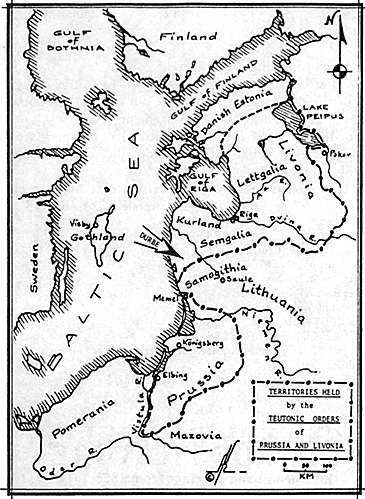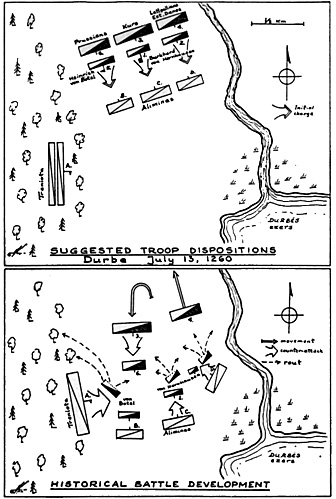 The much neglected medieval period is showing more
popularity among wargamers, but our interest has not yet had
time to expand into all facets of those colorful times. It is not
surprising then, that although the crusades in the Holy Lands are
pursued occasionally by wargaming types, the fact that
crusading was a primary military and political activity throughout
Medieval Europe as well, is generally ignored. just as Pope Urban
Il preached the original crusade at the Synod of Clermont in 1095,
so did Pope Alexander III launch the Baltic Crusade against the
pagans, 80 years later. 20 years after that, the crusade to Livonia
began, followed by Estonia and Prussia in 1216 & 1226
respectively.
The much neglected medieval period is showing more
popularity among wargamers, but our interest has not yet had
time to expand into all facets of those colorful times. It is not
surprising then, that although the crusades in the Holy Lands are
pursued occasionally by wargaming types, the fact that
crusading was a primary military and political activity throughout
Medieval Europe as well, is generally ignored. just as Pope Urban
Il preached the original crusade at the Synod of Clermont in 1095,
so did Pope Alexander III launch the Baltic Crusade against the
pagans, 80 years later. 20 years after that, the crusade to Livonia
began, followed by Estonia and Prussia in 1216 & 1226
respectively.
Early 13th century France spawned the Albigensian Crusades against Cathar heretics, Iberian wars for the reconquering of Spain were in full swing, and so on. Crusading was a widespread and "noble" cause against all non- Christians in the "civilized" world with the Inquisition as a lasting example of the extreme. The legacy left by these activities lives with us to this day and is especially evident in Eastern Europe and the Baltic seacoast.
Our scenario is in Kurland the westernmost region of present day Latvia which, in the 13th century, was under the domination of the crusading Teutonic Order, under the auspices of the Archbishop of Riga. A large portion on Kurland later became part of the vast Lithuanian Kingdom, but during the early Baltic Crusades, it was in constant military and political conflict between the Teutonic Knights, the local clans were recruited into Teutonic Order service against the stronger and better organized Lithuanian resistance.
The Samogithian (Samaiten) region, in particular, was always troublesome to the crusading progress and were among the last pagans to be Christianized in Europe. The Teutonic Knights already suffered 2 major defeats at the hands of the Samogithians (Saule, 1236 & Schoden, 1259) before the Battle of Durbe - our scenario and one of the most important battles of the Baltic Crusade.
THE BATTLE OF DURBE: 13 July, 1260 - Kurland
After Mindaugas united the Baltic clans to form the Lithuanian State and was crowned King in 1253, the Samaiten region was ceded to the Teutonic Knights in hopes of keeping them out of other Lithuanian territory so that the new kingdom could grow and develop unhindered. Mindaugas already had enemies to the East and South (Russians, Mongols and Poland) without adding the Christian crusaders West and North of his borders. He knew the Samaiten Lithuanians (Samogithians) would not give in to Teutonic Order domination without a fight and, in fact, supported their resistance efforts. They had already demonstrated their military prowess in 1236 at Saule, where the Schwertbruder Order was annihilated, and were now besieging a castle in Kurland.
On hearing of the Teutonic Orders approaching relieving force, they marched NW to a battleground of their own choosing and met the enemy on their own terms. They were facing the combined armies of Livonian and Prussian segments of the Teutonic Order, supported by numerous secular knights, crusading "pilgrims" and local clans in their employ a considerable force. Right flank protected by the Durbe River, the Lithuanian vanguard, under Aliminas, feigned flight before the charging knights and, true to typical light cavalry tactics, led them into ambush by the main forces commanded by the Samogithuan leader Treniota. Adding to the orders problems, the native Lettgalians and Estonian Danes, pressed into its service, quit the field, followed by the Kurs.
The latter, perhaps most resentful of Teutonic domination, went a step farther and struck the knights from the rear, effecting a complete encirclement. It was a disastrous defeat for the Teutonic Order with far reaching consequences. Lithuanians moved into abandoned Teutonic Order with far reaching consequences. Lithuanians moved into abandoned Teutonic castles in Kurland, geographically dividing the 2 branches of the Order, followed by major uprising of the Kurs, Letts and Semgallians, leading to continuous wars against the Teutonic oppression well into the 15th century.
SUGGESTED ARMY COMPOSITION
Durbe 13 July 1260 (Each figure = 20 troops)
TEUTONIC ORDER (Unit type Morale Number)
LIVONIAN:
1. Teutonic Knights HC Elite 15
2. Secular Knights HCVeteran 15
3. Kurs (50% archer's)* LC Militi 55
4.Lettgalians & Est. Dane LC Militia 40
PRUSSIAN:
5.Teutonic (& sec.) Knights HC Elite 15
6.Prussians & pilgrims Mc Regular 50
Total 190
SAMAITEN LITHUANIANS
A.Treniota's division LC Veteran 90
B.Archer's* LC Regular 15
C.Aliminas' division LC Veteran 30
D.Archer's* LC Regular 15
Total 150
*Armed with simple self-bows.
NOTE: If infantry was present, they played little, if any, part in the battle contemporary sources are not clear on this point, but appear to indicate an all-cavalry engagement.
To determine if the local (militia) contingent's of the Teutonic forces desert them, two 6-sided dice may be tossed for each unit as follows:
REFERENCES
W. Urban, The Baltic Crusade, 1975
D. Seward, the Monks of War
Scriptures Return Livonivarum, 1853
Scriptures Return Prussicarum, 1863
A. Gerutis, Lithuania, 700 years
Z. Raulinaitis, Durbes Musis
J. Voigt, Geschichte Pruessens, III Bd. 1828
E. Chudzinski, Die Erobening Kurlands dutch den
Deutschen Orden im 13 Jahrhundert, 1917
P. Lelis, Krvziuociu Ordinas, Karvs Nr. 3 (March, 1981)
| Dice | Kurs (unit 3) | Lettgalians, etc. (unit 4) |
|---|---|---|
| 11,12 (8.3%) | Obey orders. | Obey orders. |
| 9,10 (19.3%) | Quit the field during the first move | Obey orders. |
| 6,7,8 (44.6%) | Attack Teutonic Order from the rear after the first 2 moves.** | Quit the field after the first 2 moves. |
| 4,5 (19.3%) | Quit the field during the first move. | Quit the field during the first move. |
| 2,3 (8.3%) | Obey orders. | Follow the Kurs and do as they do. |
| **If the Kufs revert to Lithuanian side and attack the Teutonic units, they fight as Regular morale class troops. | ||

Back to Table of Contents -- Courier #62
To Courier List of Issues
To MagWeb Master Magazine List
© Copyright 1993 by The Courier Publishing Company.
This article appears in MagWeb.com (Magazine Web) on the Internet World Wide Web.
Other articles from military history and related magazines are available at http://www.magweb.com